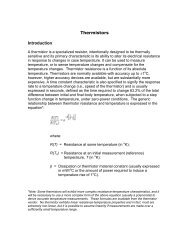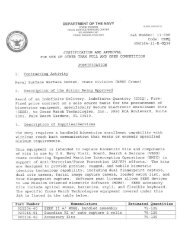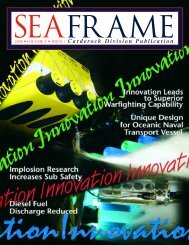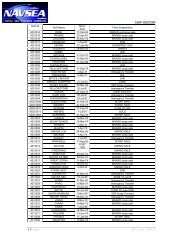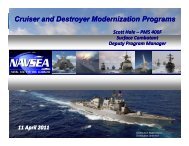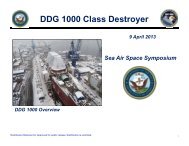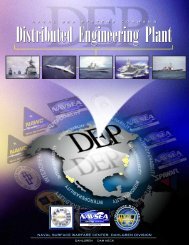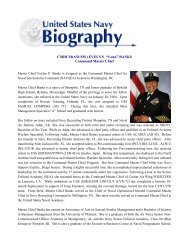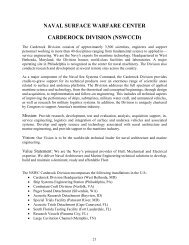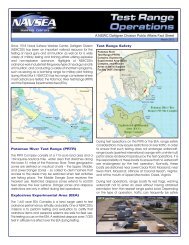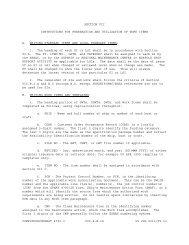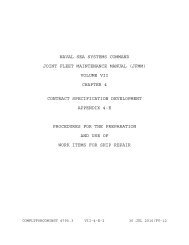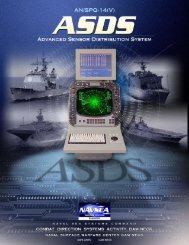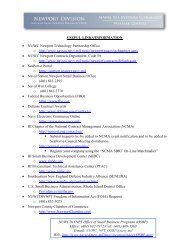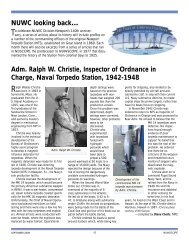Volume 6, Issue 1 - Naval Sea Systems Command - The US Navy
Volume 6, Issue 1 - Naval Sea Systems Command - The US Navy
Volume 6, Issue 1 - Naval Sea Systems Command - The US Navy
Create successful ePaper yourself
Turn your PDF publications into a flip-book with our unique Google optimized e-Paper software.
Core equities<br />
Above: LCACs like the one pictured above are currently in a life-extension program that will add 10 years to the vehicles’<br />
service life. <strong>The</strong>re will be a significant need for the SSC once LCAC end-of-life component and material issues start to appear.<br />
U.S. <strong>Navy</strong> photo.<br />
R&D LCAC craft, characterizing structural loading in high<br />
sea states likely to be encountered in real life. <strong>The</strong> design<br />
development of the SSC craft is leveraging actual data<br />
gathered from LCAC assets, with full-scale load testing<br />
and hydrodynamic testing performed using LCAC models.<br />
Since a full-scale SSC vehicle does not exist yet, the LCACderivative<br />
data is being used and can be modified to fit SSC<br />
parameters as the SSC design matures.<br />
As Carderock Division supports the SSC design<br />
there is also a significant focus on improving reliability<br />
and maintainability while reducing total ownership costs.<br />
Jeff Merlino, the machinery systems integrator for the<br />
SSC project, says one of the unique aspects of this project<br />
was that the program office responsible for the platform’s<br />
acquisition and life-cycle management are one in the<br />
same. “Typically in these situations,” he says, “you have<br />
a program manager responsible for acquisition through<br />
delivery, and another program manager responsible for<br />
managing in-service assets. We’ve been given a unique<br />
opportunity in that [the two are] the same person. <strong>The</strong><br />
benefit of that has been us being held more accountable<br />
[than most before us] with our early design decisions based<br />
on how they affect life-cycle cost effectiveness.”<br />
<strong>The</strong> design has come through an analysis of<br />
alternatives, as well as a set-based design period. <strong>The</strong><br />
preliminary design is complete and is currently in the<br />
contract design phase. <strong>The</strong> Design Acquisition Board<br />
(DAB) granted Milestone A approval in the third quarter of<br />
FY 09, and since then the contract design phase has been in<br />
full swing. <strong>The</strong> first SSC craft is expected to be delivered<br />
in FY 16 and will be a test and training craft that will be<br />
used by the <strong>Navy</strong> for test, training, and further research<br />
and development studies. Follow-on craft will become fleet<br />
assets with delivery to the fleet expected in FY 17.<br />
Technical Points of Contact<br />
Timothy Sipe<br />
timothy.sipe@navy.mil<br />
215-897-7581 (DSN 443)<br />
Lance Shappell<br />
lance.shappell@navy.mil<br />
215-897-1972 (DSN 443)<br />
Jeffrey Merlino<br />
jeffrey.merlino@navy.mil<br />
215-897-7289 (DSN 443)<br />
Core Equity Leader, Machinery <strong>Systems</strong><br />
Patricia Woody<br />
patricia.woody@navy.mil<br />
215-897-8439 (DSN 443)<br />
SEAFRAME<br />
21



